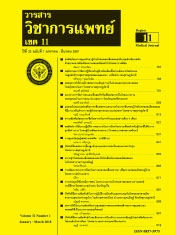Prevalence of Stroke and Stroke Risk Factors in Kanchanadit Hospital
Keywords:
Prevalence of stroke,, Stroke risk factorsAbstract
Introduction : Stroke is important problem in Thai public health. There are top cause of death and disability adjusted life year. Even survival patients carry over of disability. Ministry of public health force to developing stroke service plan for decrease mortality rate. Whereas increase access service with good quality,decrease complications, recurrent and disability of stroke. The goal of mortality rate of stroke less than 7% in 2017. Therefore Kanchanadit hospital realized in priority of stroke. Objective : To study the prevalence and risk factors of stroke patients in Kanchanadit hospital.Material and Method : Identified and analyzed as a cross-sectional analysis by collected data sampling of population since 23 June 2017 to 31 December 2017. Furthermore analyzed by descriptive statistic that was number, percent, mean, standard deviation and inferential statistic that was Chi-square test, ODDs ratio.
Results : Prevalence of stroke in Kanchanadit hospital was 8.46%. One hundred and twenty one patients were diagnosed with stroke. Mean age ± S.D. of them were 68.82 ± 12.18 years-old. 73.6% are graduated at primary education. 82.6% had ischemic stroke. Hypertension and hyperlipidemia were significantlyrisk factors of stroke (p < 0.001 and p < 0.001, respectively). However, diabetes mellitus, atrial fibrillation and previous stroke were not associate (p=0.161, 0.145 and 0.315, respectively).
Conclusion : Hypertension and hyperlipidemia were major risk factors of stroke in Kanchanadit hospital. So the healthcare providers should be aware and emphasize about this for prevention stroke.
References
สุชาติ หาญไชยพิบูลย์กุล และคณะ. ความชุกโรคหลอดเลือดสมองและปัจจัยเสี่ยงโรคหลอดเลือดสมองในประเทศไทย: โครงการศึกษาระบาดวิทยาโรคหลอดเลือดสมองในประเทศไทย. จดหมายเหตุทางแพทย์. 2554;94(4):427-36.
ศรีเมือง พลังฤทธิ์, สมบัติ มุ่งทวีพงษา. ปัจจัยเสี่ยงของโรคหลอดเลือดสมอง จังหวัดปทุมธานี ประเทศไทย. จดหมายเหตุทางแพทย์. 2558;98(7):649-55.
Areechokchai D, Vijitsoonthornkul K, Pongpan S, Maeakhian S. Population Attributable Fraction of Stroke Risk Factors in Thailand: Utilization of Non-communicable Disease Surveillance Systems. 2017;10(1):1- 6.
เสกสรร จวงจันทร์. ปัจจัยที่มีความสัมพันธ์กับการเกิดโรคหลอดเลือดสมองในผู้ป่วยโรคความดันกับการเกิดโรคหลอดเลือดสมองในผู้ป่วยโรคความดันโลหิตสูงรพ.บึงบูรพ์ จังหวัดศรีสะเกษ. วารสารวิชาการแพทย์เขต 11. 2558;29:233-39.
กฤษณา พิรเวช, วิวรรณ วิวัฒน์กุล. ปัจจัยเสี่ยงของโรคหลอดเลือดสมองในผู้ป่วยไทย. จดหมายเหตุทางแพทย์. 2546;86 (ฉบับพิเศษ 2): 291-98.
โตมร ทองศรี และคณะ. ความเสี่ยงต่อการเกิดโรคหลอดเลือดสมองของประชากรในเขตเทศบาลนครพิษณุโลกที่ตรวจสุขภาพประจำปีโดย Modified Framingham Stroke Risk Profile. พุทธชินราชเวชสาร. 2553;27:285-92.
กฤดา ณ สงขลา. Relationship between the ischemic stroke subtypes and risk factors included clinical outcome from Prasat Neurological Institute stroke registry. วารสารสมาคมโรคหลอดเลือดสมองไทย. 2557;13:3-12.
ดิษยา รัตนากร, ชาญพงค์ ตังคณะกุล, สามารถ นิธินันท์ และคณะ. Current Practice Guideto Stroke Management. : กรุงเทพฯ. 2554.
สถาบันประสาทวิทยา. แนวทางการรักษาโรคหลอดเลือดสมองตีบหรืออุดตันสำหรับแพทย์. 2558.
Feigin VL, et al. Global Burden of Diseases, Injuries, and Risk factors Study 2010 (GBD 2010) and the GBD Stroke Experts Group. Global and regional burden of stroke during 1990-2010: findings from the Global Burden of Disease Study 2010. Lancet 2014;383:245-54.
Matthew P, et al. Sugar-and Artificially Sweetened Beverages and the Risks of Incident Stroke and Dementia A Prospective Cohort Study. American Heart Association/American Stroke Association Stroke. 2017;48:1-8.
ธนบูรณ์ วรกิจธำรงค์ชัย, ทัศนีย์ ตันติฤทธิศักดิ์,สุชาติ หาญไชยพิบูลย์กุล. Novel Risk Factors for Ischemic stroke. จุลสารสมาคมโรคหลอดเลือดสมองไทย. 2556;12:23-6.
Tanne D, et al. Prospective study of serum homocysteine and risk of ischemic stroke among patients with preexisting coronary heart disease. Stroke. 2003;34:632-6.
Martinelli I, et al. High risk of cerebral-vein thrombosis in carriers of prothrombin-gene mutation and in users of oral contraceptives. N Engl J Med 1998;338:1793-7.
Mora S, et al. Additive value of immunoassay-measured fibrinogen and high-sensitivity C-reactive protein levels for predicting incident cardiovascular events. Circulation. 2006;114:381-7.
Beamer N, et al. Fibrinogen and the albumin-globulin ratio in recurrent stroke. Stroke. 1993;24:1133-9.
Rothwell P, et al. Fibrinogen concentrationand risk of ischemic stroke and acute coronary events in 5113 patients with transient ischemic attack and minor ischemic stroke. Stroke. 2004;35 :2300-5.






